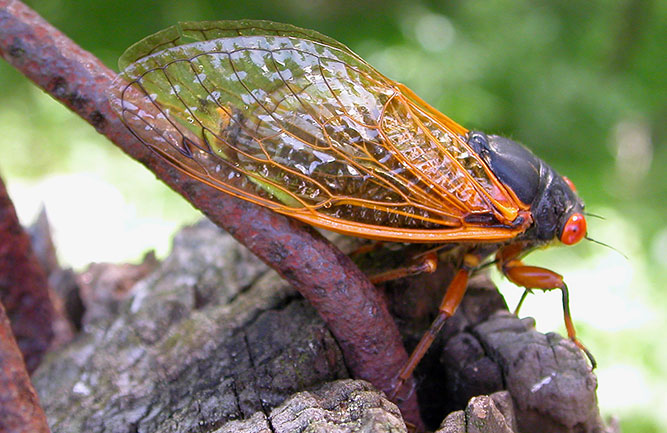Turf MD: The spring invasion of the periodical invasion

Karl Danneberger
In late spring of 2004, I was a spectator at a PGA Tour event. I remember standing around the 11th green when the marshals raised their hands to quiet the crowd in response to a golfer getting set to hit his shot. What occurred at that moment was a deafening humming sound from the surrounding trees.
Adding to the constant noise was the occasional shriek from a spectator being hit by a small flying object. It was apparent that millions of these periodical cicadas had little respect for marshals.
This spring, the 17th-year periodical cicadas will return to large areas of the northeastern United States. Periodical cicadas do not cause turf or landscape damage and go unnoticed for 16 of the 17 years. They spend almost their entire life underground feeding on the juices of plant roots, mostly deciduous tree roots. Feeding occurs to a depth of 2 feet.
As time progresses, the leadup year (16th) sees increased feeding by nymphs. This feeding does not cause long-term damage to the plants. It has been noted that mole activity increases as the 17th year approaches due to the increasing nymph activity. The year following periodical cicada emergence, mole activity falls off, most likely due to the lack of nymphs.
This spring, the 17th year of the cicada life cycle, the nymphs will emerge when soil temperatures reach 64 degrees F. The density at which the nymphs emerge can be as high as 40 per square foot in a highly synchronized fashion. Given the highly synchronized emergence of periodical cicada, which is unique to only a few species out of 3,000 species, the one-year life cycle is a biological wonder. Upon emergence, the nymphs quickly climb nearby vegetation where they molt and wait for a week in the trees for their exoskeleton to harden.
Given that the periodical cicada does not cause turf damage, I asked David Shetlar, Ph.D., professor emeritus, about the main concerns with periodical cicadas in turf.
“There are times that the cicadas can be really annoying, especially to golfers. After the cicadas have first emerged, they tend to do a lot of flying back and forth to find mates and places to lay eggs. They are pretty clumsy flyers, so they tend to run into golfers and spectators, and, being relatively heavy, it can be a good thump when one runs into you.”

Cicada (Photo:
2manydogs / iStock / Getty Images / Getty Images Plus)
In a recent study, researchers found that the chitin level in the wings of a periodical cicada is considerably higher than a locust (the cicada is not a locust). The heavier wings are believed to be a possible cause of the clumsiness in the flight and abruptness of when cicadas crash into a golfer.
Periodical cicadas males mostly cluster in what are known as chorus trees. The males make their mating sound by contracting or pulling their tymbals (ribs) in, causing a clicking sound. When they release the ribs, another clicking sound is made. The accumulative sound generated from these trees can reach 100 dba.
From an annoyance perspective, the periodical cicadas are attracted to the sound of mowers and power tools and will land on the operators. From a maintenance perspective, the periodical cicada is less active early in the morning or at dusk. Maintenance operations should be targeted toward these times of the day.
The emergence of the periodical cicada occurs for only one purpose: to mate. The females will create small slits into twigs or branches where they will lay their eggs. The eggs hatch, and the nymphs drop to the ground and burrow down into the soil to begin their 17-year (or 13-year, depending on the species) life cycle.
On a closing note, Shetlar passed on to me the most common question asked of him regarding the periodical cicada. Dogs and cats like to eat periodical cicada. Oftentimes, the pets will throw up a mass of chewed up black and orange cicada remains. Cicadas are not poisonous and can be eaten, but if pets eat too many of them at one time, they often ends up regurgitating them to make room in their stomachs.
This year, I plan on returning to that PGA Tour event, if allowed, but I will be packing ear plugs and ducking down each time the marshals raise their hands.










